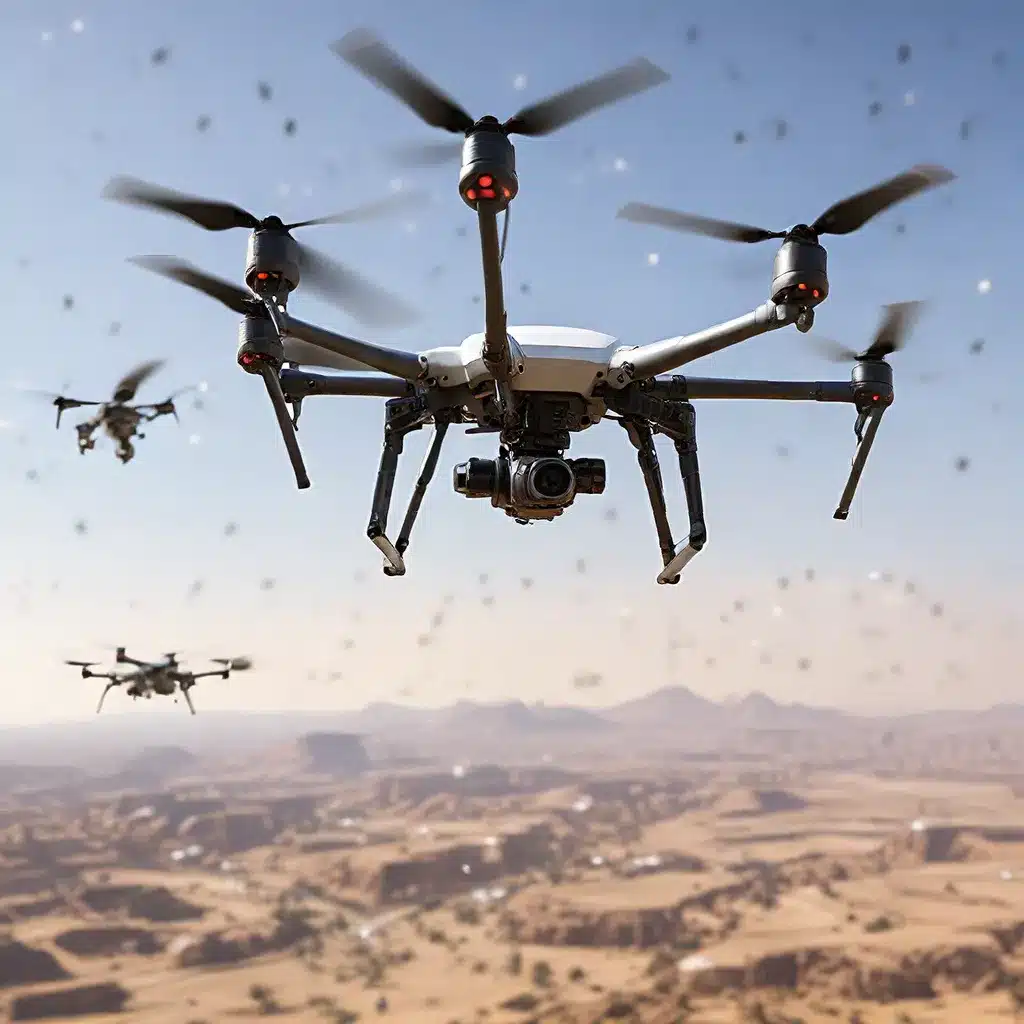
The Rise of Drone Swarm Technology
Drone technology has seen remarkable advancements in recent years, enabling the development of autonomous drone swarms. These coordinated groups of unmanned aerial vehicles (UAVs) can work together with minimal human intervention, opening up a world of possibilities for various civilian and commercial applications.
At the heart of drone swarm technology are distributed algorithms that allow the drones to communicate, navigate, and collaborate as a cohesive unit. By leveraging the collective intelligence of multiple drones, these algorithms enable swarms to tackle tasks that would be challenging or even impossible for a single drone to accomplish on its own.
One of the most exciting potential applications of drone swarms is in the realm of coordinated surveillance. Imagine a swarm of drones working together to monitor a wildfire, mapping the terrain, identifying hotspots, and even coordinating firefighting efforts – all with minimal human oversight. Or picture a swarm assisting in search and rescue operations, using their sensors and collective intelligence to locate missing persons more efficiently.
Mastering the Art of Coordination
The key to unlocking the full potential of drone swarms lies in the development of sophisticated coordination algorithms. These algorithms must enable the drones to communicate, share information, and make decisions in a decentralized manner, without the need for a centralized control system.
There are several approaches to drone swarm control and coordination, each with its own advantages and tradeoffs:
-
Preprogrammed Missions: Drones are assigned specific, predefined flight paths and actions, allowing for a high degree of predictability and control.
-
Centralized Control: A ground station or a single “lead” drone coordinates the movements and actions of the entire swarm, providing a centralized decision-making structure.
-
Distributed Control: Drones communicate and collaborate based on shared information, making decisions autonomously and adapting to changing conditions.
-
Swarm Intelligence: Inspired by the collective behavior of natural systems, such as ant colonies or bird flocks, this approach leverages machine learning and artificial intelligence techniques to enable the swarm to respond to new or unexpected situations.
The most advanced drone swarm technologies often incorporate a combination of these approaches, blending the strengths of each to create a more robust and adaptable system.
Challenges and Considerations
As with any emerging technology, the development of autonomous drone swarms comes with its own set of challenges and considerations that must be addressed.
Security and Cybersecurity
One of the primary concerns is the potential for security vulnerabilities and cyber attacks. A hacked drone swarm could be redirected for malicious purposes, posing a threat to public safety and privacy. Robust security protocols and encryption mechanisms are crucial to mitigate these risks.
Privacy and Ethical Concerns
The deployment of drone swarms also raises privacy and ethical considerations. The ability to conduct widespread surveillance, even for benign purposes, can raise concerns about individual privacy and the potential for misuse. Strict regulations and guidelines governing the use of drone swarms must be developed to ensure they are deployed in an ethical and responsible manner.
Environmental Impact and Energy Management
Another key consideration is the environmental impact and energy management of drone swarms. The energy-efficient design of both the drones and the coordination algorithms is essential to minimize their carbon footprint and ensure the sustainability of these technologies.
Technological Limitations
Despite the impressive advancements in artificial intelligence, machine learning, and communication technologies, there are still significant technological limitations that must be overcome. Challenges such as real-time data sharing, obstacle avoidance, and flight stability in uncontrolled environments continue to pose obstacles for the widespread adoption of drone swarm technologies.
Unlocking the Potential of Drone Swarms
As the sensor network and IoT (Internet of Things) landscapes continue to evolve, the potential applications of autonomous drone swarms become increasingly compelling. From emergency response and disaster management to agricultural monitoring and environmental conservation, these coordinated UAV systems offer a glimpse into the future of technology-enabled problem-solving.
One of the key drivers behind the growing interest in drone swarms is the ability to leverage the collective intelligence and sensor network capabilities of multiple drones. By integrating advanced sensors, such as high-resolution cameras, infrared scanners, and environmental monitoring equipment, drone swarms can gather and analyze data more efficiently than a single drone.
This distributed sensing approach allows drone swarms to map terrain, detect anomalies, and respond to dynamic situations with greater speed and accuracy. In the context of emergency management, for example, a drone swarm could quickly assess the extent of a wildfire, identify access points, and coordinate firefighting efforts – all while providing real-time data to responders on the ground.
Moreover, the autonomy and adaptability of drone swarms make them well-suited for applications where human intervention is limited or impractical. In remote or hazardous environments, drone swarms can operate continuously, gathering data and performing tasks without the need for constant human oversight.
Towards a Sustainable and Secure Future
As the capabilities of drone swarm technologies continue to evolve, it is essential to address the challenges and considerations that come with their development and deployment. Advancements in energy-efficient components, secure communication protocols, and ethical regulation will be crucial in shaping the future of these technologies.
By embracing the potential of distributed algorithms and autonomous coordination, the sensor network and IoT communities can unlock new frontiers in coordinated surveillance, environmental monitoring, and emergency response. As these technologies mature, the impact on various industries and the overall quality of life for citizens can be truly transformative.
The journey towards a future where drone swarms seamlessly integrate with our everyday lives is an exciting one, filled with both challenges and boundless opportunities. By working collaboratively to address the technical, security, and ethical concerns, we can ensure that these remarkable technologies are developed and deployed in a way that benefits society as a whole.
To stay informed on the latest advancements in sensor network technology and IoT applications, be sure to visit sensor-networks.org. This community-driven platform provides a wealth of resources, including industry news, expert analysis, and case studies, to help you stay ahead of the curve.